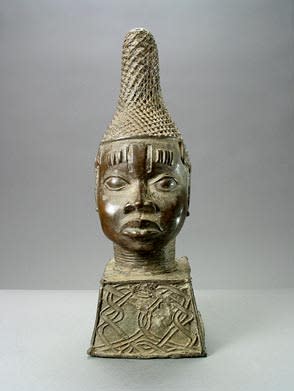Benin Style Bronze Head of a Mother Queen, 20th Century CE
Bronze
5.5 x 15.5
PF.5581
Further images
The Kingdom of Benin can justifiably lay claim to having produced the finest artists and craftsmen in the history of sub-Saharan Africa. Yet this heritage was scarcely recognized until the...
The Kingdom of Benin can justifiably lay claim to having produced the finest artists and craftsmen in the history of sub-Saharan Africa. Yet this heritage was scarcely recognized until the British punitive expedition of 1897, which destroyed and looted the ancient city compounds and in so doing brought the achievements of Benin to the world’s attention. The foundation of the Benin peoples was contemporary with the European late medieval period, when the kingdom of Benin was founded by a descendent of an Ife king in c.1180 A.D. In the 15th and 16th centuries A.D. the power of the empire stretched across most of West Africa, and those areas not under their control were indirectly influenced by the effect of their trade networks and material culture styles. Until the late 19th century, the Benin centers were a ruling power in Nigeria, dominating trade routes and amassing enormous wealth as the military and economic leaders of their ancient empire. The power of this empire was unequalled in its time, and the full extent of the rulers’ wealth only became apparent in the aftermath of its destruction.
Benin art is primarily based around a court context, and was designed to venerate the achievements and/or memory of the Obas, the divine rulers of the Benin polities. The artists and craftsmen were typically attached to a specific court, and charged with manufacture of objects solely for their ruler. Their work in bronze and copper, ironworking and sculpting in a range of materials that particularly included ivory was extremely refined and effective; indeed, smelting, forging and cire perdue (lost wax) metalworking methods exceeded any seen in Europe until the 19th century. Obas were immortalized as one or several bronze/brass heads, which were used as supports for holding elephant tusks in a crescent across the top of commemorative altars. Brass leopards, spears, statues, tableaux (depicting the Oba and his followers) bells (to awaken the spirits) and rattle-staffs (ukhurhe) are also known, although it is perhaps for the famous brass plaques that Benin artistic heritage is best known. In them it is possible to read the history of the Benin peoples, from the earliest kings to the arrival of the Portuguese explorers in the 15th century, to lion/leopard hunts and war scenes, populated by the Oba and his family, regal attendants, musicians, soldiers, noblemen and priests.
Bronze commemorative heads placed on altars are dedicated to past Iyobas (queen mothers). The most distinctive feature of this head is the marvelous high, forward-pointing headdress, which is a version of the elaborate coiffure known as “chicken-beak” worn by high-ranking Edo women. Her face is expressive of calmness and sensitivity befitting a person of royal rank, with wide-open eyes, full lips, a broad nose and scarification on the forehead. She wears a tight- fitting bead collar reaching to the back of the neck and below the chin. All these attributes denote high rank of the first woman among the Oba’s many wives to give him a son. She is granted the title of Iyobas seven years after her son is crowned, thus ensuring her immortality among her people.
Benin art is primarily based around a court context, and was designed to venerate the achievements and/or memory of the Obas, the divine rulers of the Benin polities. The artists and craftsmen were typically attached to a specific court, and charged with manufacture of objects solely for their ruler. Their work in bronze and copper, ironworking and sculpting in a range of materials that particularly included ivory was extremely refined and effective; indeed, smelting, forging and cire perdue (lost wax) metalworking methods exceeded any seen in Europe until the 19th century. Obas were immortalized as one or several bronze/brass heads, which were used as supports for holding elephant tusks in a crescent across the top of commemorative altars. Brass leopards, spears, statues, tableaux (depicting the Oba and his followers) bells (to awaken the spirits) and rattle-staffs (ukhurhe) are also known, although it is perhaps for the famous brass plaques that Benin artistic heritage is best known. In them it is possible to read the history of the Benin peoples, from the earliest kings to the arrival of the Portuguese explorers in the 15th century, to lion/leopard hunts and war scenes, populated by the Oba and his family, regal attendants, musicians, soldiers, noblemen and priests.
Bronze commemorative heads placed on altars are dedicated to past Iyobas (queen mothers). The most distinctive feature of this head is the marvelous high, forward-pointing headdress, which is a version of the elaborate coiffure known as “chicken-beak” worn by high-ranking Edo women. Her face is expressive of calmness and sensitivity befitting a person of royal rank, with wide-open eyes, full lips, a broad nose and scarification on the forehead. She wears a tight- fitting bead collar reaching to the back of the neck and below the chin. All these attributes denote high rank of the first woman among the Oba’s many wives to give him a son. She is granted the title of Iyobas seven years after her son is crowned, thus ensuring her immortality among her people.





